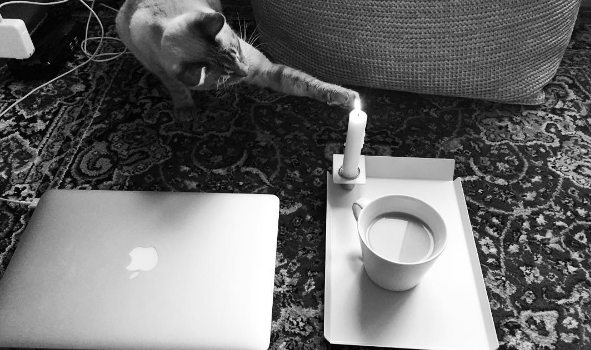 Freelance
Freelance
5 1/2 Additional Jobs of a Freelance Copywriter
Freelance copywriting sounds glamorous to all my friends. “You get to work at a coffeeshop, and travel, and blog!” But as a freelancer, I take on way more roles than simply “copywriter.” Much of it isn’t glamorous. Here are the top 5 (and a half … you’ll see …) jobs I find myself doing on a daily basis, plus ways to tackle these non-copywriting challenges.
1. Finance
Goodbye W2s. Hello 1099-MISC and 1040 ES forms. As a freelancer, there’s no one making sure you’re taking out the proper taxes. It’s on you. It’s also on you to set fair rates (don’t forget to account for all the time spent in meetings, emailing, uploading docs and commenting in project management systems), track time, and invoice each of your clients (inevitably, many clients have a preferred way of invoicing).
Advice:
- Track each payment (I use a Google spreadsheet) so you’re prepared for quarterly taxes
- Stay on top of clients who owe you money
- Keep a folder of your receipts for tax write-offs
- Invoice as soon as projects are wrapped (believe me, it’s actually easy to forget to get paid!)
2. PR/Marketing
Sometimes, freelance work just comes to you. A friend told a friend, and BAM! You’ve got a project. But most work requires some hustle. Unlike full-time employment, “steady” doesn’t really apply to freelance work. Sure, you can find ongoing projects that provide steady income, but when you’re working with multiple clients on multiple projects, there’s inevitably some ebb and flow–and some time holes to fill.
Advice:
- Update your LinkedIn (and post your latest work!)
- Maintain your online portfolio (don’t go 5 years without a refresh like I did …)
- Spread the word to friends and colleagues when you’re looking for new work
- Ask current clients if there’s more you can take on
3. Project Management
Some of my clients are great at planning. Many are totally not. When you’re in the creative world, you get used to people who are completely disorganized and, occasionally, down right chaotic.
As a freelancer, managing several simultaneous projects from different clients gets hectic–and time consuming. Here’s a snapshot of my current world, by the #s:
1-8 clients on any given day
6 different email accounts
5 project/content management systems
4 time zones spanning 3 countries
2 VPNs
11 PM latest meeting time
Syncing your schedule to line up with various teams is near impossible, so flexibility goes a long way. But it goes the other way, too. If you have zero work on a given day, that means you have nothing to bill for. Clients can’t expect you online 24/7–unless, of course, they’re paying you for it.
Advice:
- Forward all your emails to one address (but remember to send from the correct one)
- Set schedule expectations with your clients from the get-go
- Attempt to work most of your hours at the same time most of your clients are also online
- Stick to your hours 90% of the time; you don’t want to set the expectation that you’re always available (easier said than done)
4. HR
The worst thing about being a freelancer is when you get sick. The second worst thing? Figuring out when/how to schedule vacation without having to bring your laptop–or lose out on work. As a freelancer, you don’t have the perk of a benefits package. But it’s also not (necessarily) a reason to skip out on a conference that’s coming to town, just because it’s on your own dime.
Advice:
- Designate a backup, someone you trust to complete a project if you get sick at the last second
- Plan time off (and plan your hourly rate around it) as far out in advance as possible
- Notify clients ASAP of schedule changes
- Maintain your own self-development/improvement via conferences, meet-ups, reading, etc.
5. IT
“You can work from anywhere!” your friends say. Sure, if it has Internet. That works. And cellphone service. That doesn’t drop out. For the non-tech-savvy, freelance is stressful when routers stop working, passwords are forgotten, and calendar reminders fail to remind.
Advice:
- Take advantage of the work-from-anywhere perk, but do your research on Wi-Fi spots in advance
- Have a backup plan for when chargers, your computer, phone, Internet, or any other must-haves break (libraries come in handy)
- Backup everything, all the time, and then do it again (I use both Dropbox and an external hard drive)
- Use a site like LastPass to track your passwords and set alerts for all deadlines/meetings on your calendar
5 1/2 Design*
Why the asterisk? Well, because some copywriters just write. And that’s great if that’s all you need. Many of my projects I’ve worked on start off by someone tossing a project to me, thinking I’ll just slap some words on paper and keep ‘er moving down the assembly line. I can’t–if I can help it–write in a bubble. Writing in a bubble ultimately makes for a weak product.
Advice:
- Think visually, coming up with ideas and concepts that blend words and images
- Determine if there are layout/size constraints, or if copy can dictate it
- Work with designer(s) from the start
- Take InDesign, Photoshop, and Illustrator intro courses for familiarity and to expand your design knowledge
What additional roles do you take on with your job–and what’s your advice for taking ’em on like a champ? Leave a note in the comments!





2 COMMENTS
Katie, whilst there’s lots of awesome info on your site 🙂
This, for me at least, is probably the most useful. I’ve been ‘freelance/self/employed’ for years. Have always used the holiday (including paying someone for cover means paying for the holiday twice) and sick pay thing as price justification.
Never even mentioned the benefits and taxes conundrum.
Thank you 🙂
Glad you found it helpful, Paul! 🙂 Always important to value our time appropriately.